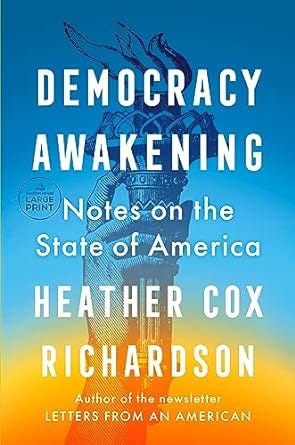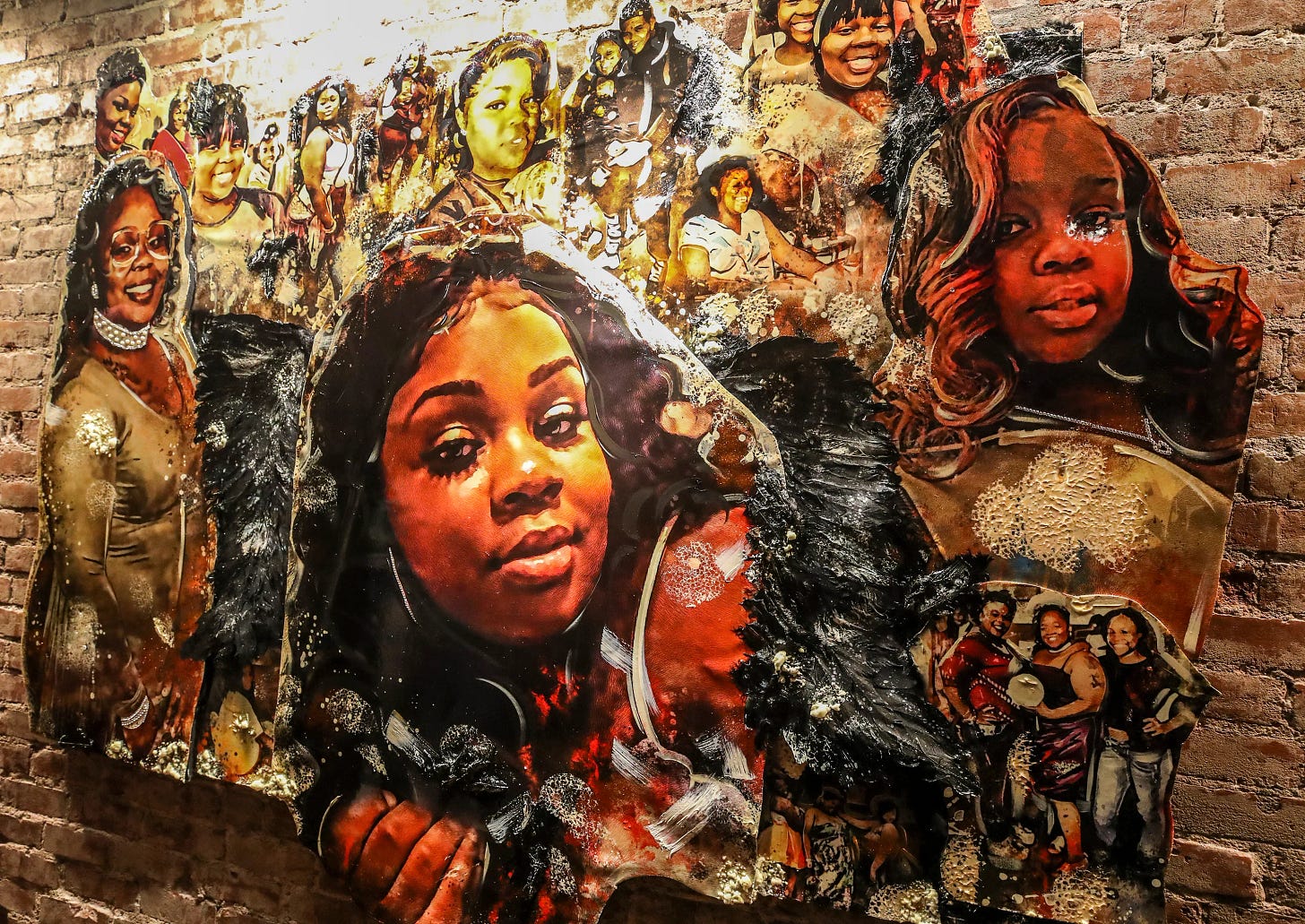Heather Cox Richardson has an audience.
No, not the 1.3+ million subscribers to her daily newsletter. Or the thousands who log on every day to watch her on Facebook Live. Or the people who purchased her new book, Democracy Awakening, propelling it to the NYT bestseller list.
This an imaginary audience to whom she writes her Letters to an American newsletter.
“I write for a graduate student in 150 years,” she told me. “One-hundred-fifty years from now, for the United States of America, what stories are the ones that I think matter?”
More than 1,500 people attended our conversation at Symphony Hall on October 24, hosted by the Springfield Public Forum and sponsored by Mass Humanities. It was a joy and an honor to talk to Richardson about those letters, the new book, and her hopes for the future of the nation.
Some takeaways…
Why the newsletter is sometimes late
We talked about that morning’s email, which arrived—for Richardson—later than usual, at 5:20am. As a rule, she won’t include anything in the newsletter that hasn’t been corroborated by three different sources. The writing slowed down in the first hours of Tuesday morning as she tried to confirm the location of the Eisenhower aircraft carrier.
“The hard part is what I’m going to say in the first place. What takes the time is the detail, and I think the detail is so important. But there are some days when I’m like, ‘Really, where did you move the carrier?’”
Her emphasis on the importance of facts is nothing out of the ordinary for a historian, but is essential to her appeal as a real-time chronicler. What readers appreciate, I think, is the dogged insistence on getting it right. In a media environment obsessed with clicks and stricken with misinformation, Richardson’s dependability and for-the-record approach attracts people for whom the noise is simply too much.
Her coverage of Joe Biden
We joked about her ranking in the Biden Crime Family, but one sometimes hears the complaint that she is an apologist for the White House. Indeed, it’s hard to recall opening an email from Richardson and finding any criticism of the president.
Her counter: “I’m keeping the public record.” She believes this administration is notable for how much information it shares—even overshares—about what it’s doing, so it’s her role to archive the president’s convenings, announcements, and legislative efforts for that graduate student who’ll uncover them in the year 2173.
“They are so deliberately changing the direction of the ship of state and telling us every single adjustment, and it just isn’t getting the play,” said Richardson when I pointed out the relative lack of coverage these things receive from other channels. For Richardson, speculation and rumor mongering is unimportant. “I don’t care about how it might play out, I care about what is playing out.”
Richardson’s emphasis on actual policies is refreshing. Still, I think there’s something to the critique of her approach to the White House. Every historian selects what they see as crucial to understanding the moment. Missteps and imperfections are fair game in that record, regardless of the officeholder. We could benefit from reading her thoughts on those, too.
The book in three parts
Democracy Awakening consists of three sections, so I structured my questions to follow that arc. If you’re a regular student of US political history, you’ll be familiar with Richardson’s analysis of the rise of conservatism since the New Deal. For those new to the terrain, this is an effective primer on the ways by which wealthy activists merged fears of socialism and the nation’s long history of racism to advocate for lower taxes, less regulation, and restrictions on voting rights. My question: What was the narrative of the Democratic Party during this period?
Her response began with a look at the Dixiecrats, the Republican nomination of Barry Goldwater, and the ultimate rupture following the 1965 Voting Rights Act. Democrats chose multicuturalism, while Republicans played to the resentments of white voters in the South. She talked about the appeal of Bernie Sanders for young people who saw Democrats of Richardson’s (younger than Bernie) generation as lacking ideas and energy. Those Democrats, she observed, were voted out.
(Note: There was a question in there about globalism that I couldn’t quite formulate, about the ways in which the conservatism she described had propelled the economic shifts that impacted the very voters it later attracted, at the expense of Democrats. It seems to me that Democrats were complicit in this economic shift, or at least failed to articulate a narrative for those voters. Alas.)
This brings us to section two and the years 2016-2021. I stay away from the publishing industrial complex that rose up to document the Trump years through the eyes of former staffers and embedded journalists. Reading the book, I felt again the surreal dread of those days.
What, I asked Richardson, stood out to her as particularly difficult to revisit during the writing process?
“It was the whole thing.” The audience and I shared a weary laugh. She described trying to edit down all that she originally intended to record, e.g., cutting the Russia investigation from twenty-seven pages to six.
“When I stripped down on all the noise, the steps towards authoritarianism were harsh.”
Where does she place the Black Lives Matter movement in the context of those years?
“Even people who had not recognized that they needed to care about Breonna Taylor, Tamir Rice, or George Floyd, believed that they were living in a society that there own lives were at stake, that they could not trust the authorities not to do the same thing to them.”
She compared BLM to the abolitionist movement in the decades prior to the Civil War. People who hadn’t considered themselves abolitionists embraced the cause of anti-slavery when the Union came under threat. In 2020, many Americans awakened to a danger that Black activists had long known.
“If we lose democracy for young Black men and young Black women, it is only a question of time until we have lost democracy altogether.”
This brought us to the final section. I read a passage that moved me from her conclusion:
“A history that looks back to a mythological past as the country’s perfect time is a key tool of authoritarians. It allows them to characterise anyone who opposes them as an enemy of the country’s great destiny.
But the true history of American democracy is that it is never finished. It is the story of people who have honored the idea that anation can be based not in land or religion or race or hierarchies, but rather in the concept of human equality.”
Richardson calls on us to embrace the histories of people who held the United States to its promises, and who fought to be included in American democracy, even if they were left out of its founders’ vision.
“You don’t have to believe the 1776 Project that everything was perfect in the past,” she said in Springfield, “and you don’t have to believe the people who say everything was miserable in the past, but in fact those two things have always gone hand in hand. It’s the people who’ve been able to dance between the two…who have given us the kind of vibrant history that will enable us to reclaim our agency and expand our democracy once again.”
Final thoughts
Heather Cox Richardson is vital to understanding America in 2023. Her analysis of the present through the past, her popularity and her unique mastery of social media will themselves be part of the record that a graduate student reads in the 22nd century. It felt historic to share a stage with her.
What I wonder about is this question of agency. What do we do with what we learn from reading Letters to an American?
Eithan Harsh, a political scientist at Tufts, wrote an important book a few years ago called Politics is Power. He distinguished between politics and political hobbyism. Politics means working with other people to influence the government. You do politics when you actively engage with the gears of power—volunteering for a campaign, participating in school board meetings or town planning committees, starting an organization.
Political hobbyism is what almost everyone does—consume news and analysis, sign online petitions, rant on social media about policies or political opponents. It has become a consuming passion for so many Americans since 2016, with the pandemic putting the phenomenon on steroids.
The distinction came to mind as I read the final pages of Democracy Awakening and when Richardson and I talked about Black Lives Matter. How do we understand that transition from a Black activist’s struggles to a mass movement, one in which we all share burdens? What understandings do we need to negotiate, what bonds remain to be formed?
To truly make political change, to follow the road laid down by those who had to fight to be included in this democracy, and to stand with those who still do, we will need to do so much more than open an email. We will need to understand the difference between awareness and sacrifice, between consuming history and making history.
I am quite sure that Richardson understands this. I hope her audience does, too.






